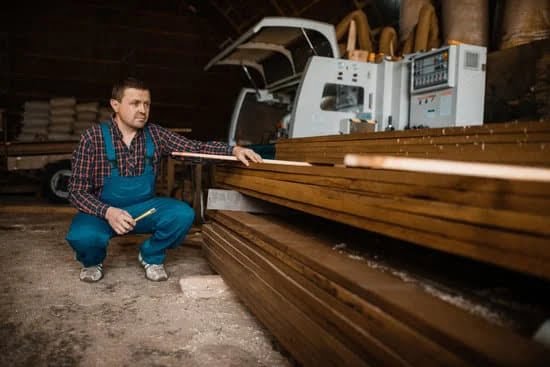Are you wondering how to mount a woodworking bench vise? A woodworking bench vise is an essential tool for any woodworker, providing the stability and grip needed to tackle a wide range of projects.
Whether you’re a professional carpenter or just enjoy woodworking as a hobby, having a properly mounted bench vise can make all the difference in the quality and efficiency of your work. In this article, we will guide you through the process of selecting the right bench vise, gathering the necessary tools and materials, preparing your workbench, and installing and securing the vise for heavy-duty woodworking projects.
A woodworking bench vise is designed to hold pieces of wood firmly in place while you saw, drill, sand, or chisel them. This tool allows for greater precision and safety when working with wood, making it an indispensable part of any woodworking shop. Whether you’re working on small crafts or large furniture pieces, having a reliable and securely mounted bench vise is crucial for achieving professional-looking results.
In this comprehensive guide, we will walk you through each step of mounting a woodworking bench vise. From selecting the right type of vise for your needs to ensuring that your workbench is sturdy enough to support it, we will provide detailed instructions and tips for every stage of the process. By following our guide, you can enhance your woodworking experience and take your projects to the next level with a properly mounted bench vise. Let’s get started.
Selecting the Right Bench Vise
When it comes to woodworking, having the right tools and equipment is essential for creating high-quality pieces. One of the most important tools for any woodworker is a bench vise. Selecting the right bench vise can make a significant difference in the quality of your work and the ease of your projects. There are several factors to consider when choosing a bench vise, and taking these into account will ensure that you select the best one for your needs.
Factors to Consider When Selecting a Bench Vise:
- Type of Woodworking Projects: Consider the type of woodworking projects you typically work on. If you work on larger, heavy-duty projects, a heavy-duty bench vise may be more suitable. For smaller, delicate projects, a lighter-duty vise may be sufficient.
- Vise Size: The size of the vise jaws and opening capacity is crucial. Ensure that the vise size can accommodate the materials you will be working with.
- Vise Material: Look for a bench vise made from durable materials such as cast iron or steel. This will ensure longevity and durability.
- Mounting Options: Different bench vises have different mounting options, such as clamp-on or bolt-on. Consider how you want to mount your vise and choose accordingly.
By carefully considering these factors, you can select a bench vise that is best suited to your specific woodworking needs.
In addition to selecting the right bench vise, it’s also important to install it properly on your workbench. In the next section, we will discuss how to mount a woodworking bench vise step-by-step to ensure stability and functionality for your woodworking projects”.
Gathering the Necessary Tools and Materials for Mounting
In order to mount a woodworking bench vise, it is essential to gather the necessary tools and materials for the task. Having the right equipment will ensure that the installation process goes smoothly and that the vise is securely mounted to the workbench. Here are some key items you will need to gather before beginning the mounting process.
First and foremost, you will need a woodworking bench vise. Be sure to select a vise that is appropriate for your needs, taking into consideration factors such as size, clamping force, and durability. Additionally, you will need a drill with drill bits suitable for the type of material your workbench is made from. It is also important to have a wrench or socket set for tightening bolts, as well as screws and washers specifically designed for mounting a vise.
Furthermore, gathering materials such as wood screws or lag bolts to secure the vise to the workbench is crucial. Depending on the design of your workbench, you may also require wooden blocks or shims to create a level surface for mounting. Additionally, having access to a level and measuring tape will ensure that the vise is installed accurately and securely.
Finally, personal protective equipment such as safety glasses and gloves should be worn while handling tools and materials during the mounting process. By ensuring that all necessary tools and materials are gathered beforehand, you can streamline the installation of your woodworking bench vise and minimize any potential setbacks during the process.
Preparing the Workbench
When it comes to mounting a woodworking bench vise, ensuring that the workbench is stable and durable is crucial for the overall functionality of the vise. Without a sturdy foundation, the vise may not perform as expected and could potentially cause safety hazards during woodworking projects. Here are some steps to prepare your workbench for mounting a bench vise:
1. Clearing the Workbench: Before beginning the mounting process, ensure that your workbench is completely clear of any tools, materials, or debris. This will provide you with ample space to work and prevent any obstructions during the installation of the vise.
2. Checking Workbench Stability: It’s important to assess whether your workbench is stable enough to support the weight and pressure that will be exerted on the bench vise during woodworking tasks. If your workbench wobbles or feels unstable, consider reinforcing it with additional bracing or supports.
3. Marking Vise Placement: Once you’ve determined the optimal location for mounting your bench vise, use a pencil or marker to outline where it will be positioned on the workbench. This will help guide you during the installation process and ensure that the vise is centered and aligned properly.
By following these key steps, you can effectively prepare your workbench for mounting a woodworking bench vise. Remember that stability and durability are essential factors in ensuring that your vise functions accurately and safely during various woodworking projects.
Installing the Vise
Mounting a woodworking bench vise is an essential skill for any woodworker, as it provides the necessary stability and support for a wide range of projects. The process may seem daunting at first, but with the right tools and careful attention to detail, it can be accomplished with relative ease.
To begin, you will need to gather the necessary tools and materials for mounting the vise. This includes a drill, screwdriver, measuring tape, wood screws, and the bench vise itself. It is important to select a high-quality vise that is suitable for your specific woodworking needs and workbench specifications.
Once you have selected the right bench vise and gathered all necessary tools, the next step is to prepare your workbench for installation. This involves ensuring that the workbench is stable and durable enough to withstand the pressure and force that will be exerted on it when using the vise. Depending on the material of your workbench, you may need to reinforce it with additional supports or braces to accommodate the weight of the vise.
| Tools Needed | Materials Needed |
|---|---|
| Drill | Bench Vise |
| Screwdriver | |
| Measuring Tape |
By taking these initial steps before installing your bench vise, you are ensuring that it will be securely mounted and ready for use in your woodworking projects. Understanding how to mount a woodworking bench vise is crucial for any woodworker looking to enhance their workspace and create sturdy pieces with ease.
Securing the Vise for Heavy-Duty Woodworking Projects
When it comes to heavy-duty woodworking projects, having a securely mounted bench vise is crucial for ensuring safety and precision. Whether you’re working on intricate furniture pieces or large-scale carpentry, the stability of your vise is essential. This section will provide a detailed guide on how to properly secure your bench vise for heavy-duty woodworking projects.
Ensuring Proper Mounting
The first step in securing your vise for heavy-duty projects is to ensure that it is properly mounted to your workbench. A sturdy and stable mounting is essential for handling the pressure and force that comes with heavy-duty woodworking. Make sure that the mounting bolts are tightened securely and that the vise is flush against the surface of the workbench.
Reinforcing the Workbench
For added stability, especially when working with heavy materials, consider reinforcing your workbench before mounting the vise. Adding additional bracing underneath the workbench or using thicker, more durable materials can provide extra support for heavy-duty woodworking projects.
Using Support Blocks
When dealing with particularly dense or hefty wood pieces, using support blocks can help distribute weight and reduce strain on the vise and workbench. By placing support blocks underneath the wood being secured in the vise, you can prevent excessive pressure on any one area of the bench vise’s jaws.
By following these steps and taking these precautions, you can ensure that your bench vise is securely mounted and ready for heavy-duty woodworking projects. Taking the time to properly secure your bench vise will not only enhance safety but also improve accuracy and efficiency in your woodworking endeavors.
Maintaining and Caring for Your Bench Vise
When it comes to woodworking, a bench vise is an essential tool for securely holding your workpieces in place. However, just like any other tool in your workshop, it’s important to properly maintain and care for your bench vise to ensure its longevity and optimal performance. In this section, we will discuss some tips and tricks for maintaining and caring for your bench vise.
Regular Cleaning and Lubrication
One of the most important steps in maintaining your bench vise is to keep it clean and well-lubricated. Sawdust, wood shavings, and other debris can accumulate in the moving parts of the vise, causing it to operate less efficiently over time.
Regularly clean the vise with a brush or compressed air to remove any buildup. Additionally, applying a lubricant such as a light machine oil or silicone spray to the threads and moving parts will help prevent corrosion and ensure smooth operation.
Checking for Wear and Tear
As with any tool, it’s important to regularly inspect your bench vise for signs of wear and tear. Check the jaws for any dents or damage that may affect their gripping power. If you notice any issues, consider replacing the jaws or any worn-out components to maintain the vise’s functionality.
Proper Storage
When not in use, it’s important to store your bench vise properly to prevent rust and damage. Keep the vise covered when not in use to protect it from moisture and dust. If possible, store it in a dry area away from extreme temperatures.
By following these maintenance tips and tricks, you can ensure that your bench vise remains in top condition for years to come, allowing you to continue enjoying seamless woodworking projects without any hassle.
Enhancing Your Woodworking Experience With a Properly Mounted Bench Vise
In conclusion, mounting a woodworking bench vise is a crucial step in creating a functional and efficient workspace for any woodworker. By understanding the importance of a bench vise and selecting the right one for your needs, you can greatly enhance your woodworking experience. Gathering the necessary tools and materials, preparing the workbench, and following a step-by-step installation guide are essential to ensure stability and durability.
Once your bench vise is properly installed, it’s important to secure it for heavy-duty woodworking projects. This involves proper maintenance and care to ensure longevity. By following some simple tips and tricks, you can keep your bench vise in top condition for years to come.
In summary, a properly mounted bench vise is a valuable asset in any woodworking shop. It provides stability, support, and versatility for a wide range of projects. By taking the time to understand how to mount a woodworking bench vise and following the necessary steps, you can greatly enhance your woodworking experience and take on more challenging projects with confidence.
Frequently Asked Questions
How Do You Mount a Workbench Vise?
Mounting a workbench vise involves choosing the right location on the workbench, ensuring the vise is level and secure, then marking and drilling holes for the mounting bolts. Once the bolts are secured, the vise can be attached.
What Should Be Avoided When Mounting Work in a Vise?
When mounting work in a vise, it’s important to avoid over-tightening, as this can damage both the workpiece and the vise itself. Additionally, sharp or pointed objects should not be clamped directly in the vise to prevent damage and injury.
Can You Mount a Vise to MDF?
It is possible to mount a vise to MDF (Medium-Density Fiberboard), but it is not ideal due to MDF’s tendency to compress under pressure. If mounting to MDF is necessary, reinforcing the area with additional material may be advisable.

Hi everyone! I’m a woodworker and blogger, and this is my woodworking blog. In my blog, I share tips and tricks for woodworkers of all skill levels, as well as project ideas that you can try yourself.





